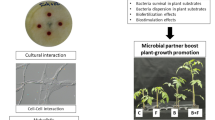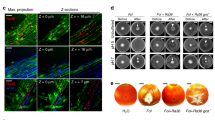Abstract
We investigated the ecological strategies exerted by the soil bacterium Burkholderia terrae BS001 at the hyphae of the soil saprotrophic fungus Lyophyllum sp. strain Karsten. Recently, this bacterium has been reported to form biofilms around, and to comigrate with, growing hyphae of Lyophyllum sp. strain Karsten. In addition, it was found to be able to utilize fungal metabolites. Here, we extend this work to shed some light on the interactions between the bacterial and fungal partner which allow ecological success for the former. In standing liquid microcosms inoculated with Lyophyllum sp. strain Karsten, we detected, upon prolonged incubation, the formation of a mycelial mat at the liquid–air interface. From this mat, primordia were formed after 4–6 weeks, which eventually resulted in mushrooms. However, upon addition of strain BS001 to the bulk liquid, mushroom formation from the fungal mat was clearly inhibited, as evidenced by (1) the formation of significantly lower numbers of primordia and (2) a delay of the onset of primordia formation. Moreover and importantly, the presence of strain BS001 caused the fungus to secrete large amounts of exudates at the mycelial mat, whereas such exudation was absent from control (uninoculated) or Escherichia coli K12- or Variovorax paradoxus BS64-inoculated microcosms. In the exudates, glycerol was the main carbonaceous component, and this compound could be easily utilized by strain BS001. Thus, in different experimental set-ups with the fungal partner, strain BS001 was shown to grow in the fungal exudates on the mat. The two fungal-interactive phenotypes were specific for B. terrae strain BS001, as the other bacteria used in our study, i.e. E. coli K12 and V. paradoxus BS64, did not exhibit any of these phenomena.






Similar content being viewed by others
References
Nazir R, Warmink JA, Boersma FGH, van Elsas JD (2010) Mechanisms that promote bacterial fitness in fungal-affected soil microhabitats. FEMS Microbiol Ecol 71:169–185
Shaw RK, Berger CN, Feys B, Knutton S, Pallen MJ, Frankel G (2008) Enterohemorrhagic Escherichia coli exploits EspA filaments for attachment to salad leaves. Appl Environ Microbiol 74:2908–2914
Partida-Martinez LP, Hertweck C (2005) Pathogenic fungus harbours endosymbiotic bacteria for toxin production. Nature 437:884–888
Partida-Martinez LP, Monajembashi S, Greulich KO, Hertweck C (2007) Endosymbiont-dependent host reproduction maintains bacterial–fungal mutualism. Curr Biol 17:773–777
Partida-Martinez LP, de Looss CF, Ishida K, Ishida M, Roth M, Buder K, Hertweck C (2007) Rhizonin, the first mycotoxin isolated from the zygomycota, is not a fungal metabolite but is produced by bacterial endosymbionts. Appl Environ Microbiol 73:793–797
Lackner G, Möbius N, Scherlach K, Partida-Martinez LP, Winkler R, Schmitt I, Hertweck C (2009) Global distribution and evolution of a toxinogenic Burkholderia–Rhizopus symbiosis. Appl Environ Microbiol 75:2982–2986
Keel C, Schnider U, Maurhofer M, Voisard C, Laville J, Burger U, Wirthner P, Haas D, Defago G (1992) Suppression of root diseases by Pseudomonas fluorescens CHA0: importance of the bacterial secondary metabolite 2,4-diacetylphloroglucinol. Mol Plant Microbe Interact 5:4–13
Rezzonico F, Binder C, Défago G, Moënne-Loccoz Y (2005) The type III secretion system of biocontrol Pseudomonas fluorescens KD targets the phytopathogenic Chromista Pythium ultimum and promotes cucumber protection. Mol Plant Microbe Interact 18:991–1001
Artursson V (2005) Bacterial–fungal interactions highlighted using microbiomics: potential application for plant growth enhancement. Doctoral Thesis, Swedish University of Agricultural Sciences, Uppsala
Artursson V, Finlay RD, Jansson JK (2006) Interactions between arbuscular mycorrhizal fungi and bacteria and their potential for stimulating plant growth. Environ Microbiol 8:1–10
Duponnois R, Colombet A, Hien V, Thioulouse J (2005) The mycorrhizal fungus Glomus intraradices and rock phosphate amendment influence plant growth and microbial activity in the rhizosphere of Acacia holosericea. Soil Biol Biochem 37:1460–1468
Johansson JF, Paul LR, Finlay RD (2004) Microbial interactions in the mycorrhizosphere and their significance for sustainable agriculture. FEMS Microbiol Ecol 48:1–13
Suárez-Moreno ZR, Caballero-Mellado J, Coutinho BG, Mendonça-Previato L, James EK, Venturi V (2012) Common features of environmental and potentially beneficial plant-associated Burkholderia. Microb Ecol 63:249–266
Bonfante, Lozano (2000) A Burkholderia strain living inside the arbuscular mycorrhizal fungus Gigaspora margarita possesses the vacB gene, which is involved in host cell colonization by bacteria. Mycol Res 39:137–144
Lackner G, Moebius N, Hertweck C (2011) Endofungal bacterium controls its host by an hrp type III secretion system. ISME J 5:252–261
Lackner G, Moebius N, Partida-Martinez LP, Boland S, Hertweck C (2011) Evolution of an endofungal lifestyle: deductions from the Burkholderia rhizoxinica genome. BMC Genom 12:210
Nazir R (2012) The ecological success of Burkholderia terrae BS001 and related strains in the mycosphere. Doctoral thesis, University of Groningen, The Netherlands
Warmink JA, van Elsas JD (2009) Migratory response of soil bacteria to Lyophyllum sp. strain Karsten in soil microcosms. Appl Environ Microbiol 75:2820–2830
Wick LY, Remer R, Würz B, Reichenbach J, Braun S, Schäfer F, Harms H (2007) Effect of fungal hyphae on the access of bacteria to phenanthrene in soil. Environ Sci Technol 41:500–505
Boer WD, Folman LB, Summerbell RC, Boddy L (2005) Living in a fungal world: impact of fungi on soil bacterial niche development. FEMS Microbiol Rev 29:795–811
Warmink JA, van Elsas JD (2008) Selection of bacterial populations in the mycosphere of Laccaria proxima: is type III secretion involved? ISME J 2:887–900
Warmink JA, Nazir R, Corten B, van Elsas JD (2011) Hitchhikers on the fungal highway: the helper effect for bacterial migration via fungal hyphae. Soil Biol Biochem 43:760–765
Boersma FGH, Otten R, Warmink JA, Nazir R, van Elsas JD (2010) Selection of Variovorax paradoxus-like bacteria in the mycosphere and the role of fungal-released compounds. Soil Biol Biochem 42:2137–2145
Cusano AM, Burlinson P, Deveau A, Vion P, Uroz S, Preston GM, Frey-Klett P (2011) Pseudomonas fluorescens BBc6R8 type III secretion mutants no longer promote ectomycorrhizal symbiosis. Environ Microbiol Rep 3:203–210
Chang S (2009) Training manual on mushroom cultivation technology. United Nations–Asian and Pacific Centre for Agricultural Engineering and Machinery (APCAEM) 1–65
Acknowledgements
We gratefully acknowledge the help of Marten Staal and Miaozhi Zhang for CO2 measurements and technical assistance in the laboratory, respectively. We thank the higher education commission of Pakistan for the financial support. Furthermore, the Soil Biotechnology Foundation is acknowledged for the financial support to RN.
Author information
Authors and Affiliations
Corresponding author
Electronic Supplementary Material
Below is the link to the electronic supplementary material.
ESM 1
(PPTX 332 kb)
Rights and permissions
About this article
Cite this article
Nazir, R., Warmink, J.A., Voordes, D.C. et al. Inhibition of Mushroom Formation and Induction of Glycerol Release—Ecological Strategies of Burkholderia terrae BS001 to Create a Hospitable Niche at the Fungus Lyophyllum sp. Strain Karsten. Microb Ecol 65, 245–254 (2013). https://doi.org/10.1007/s00248-012-0100-4
Received:
Accepted:
Published:
Issue Date:
DOI: https://doi.org/10.1007/s00248-012-0100-4




